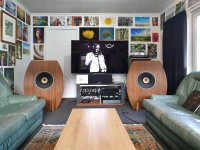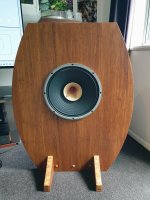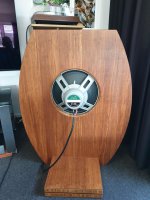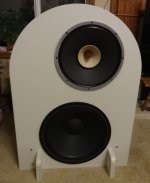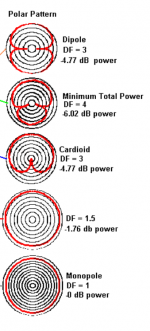I have built some Big Betsy open baffles (photos attached) using the Lii Audio F15 full-range driver and would like to try adding a tweeter.
I have ordered the Aurum Cantus AST2560 Aero Striction Tweeters , and would like to order the capacitors I will need for a range of crossover frequencies - say 6khz, 7khz, 8khz and 9 khz
The tweeters can be seen at: Aurum Cantus AST2560 Aero Striction Tweeter
Can anyone recommend a good quality capacitor, and the values needed for the frequencies I would like to try?
What considerations do I need to make for the fact that the full-range (Lii F15) drivers I am pairing the tweeters with, are 8ohm and the tweeters are 4 ohm?
I would also appreciate any advice regarding how to mount them on the baffle. The baffle is 40mm thick - should the tweeters be front or rear mounted, flush or inset, radius of rounding router bit, etc. Or is it just a matter of experimentation to see what sounds best?
Any and all suggestions appreciated
Thanks
Steve
I have ordered the Aurum Cantus AST2560 Aero Striction Tweeters , and would like to order the capacitors I will need for a range of crossover frequencies - say 6khz, 7khz, 8khz and 9 khz
The tweeters can be seen at: Aurum Cantus AST2560 Aero Striction Tweeter
Can anyone recommend a good quality capacitor, and the values needed for the frequencies I would like to try?
What considerations do I need to make for the fact that the full-range (Lii F15) drivers I am pairing the tweeters with, are 8ohm and the tweeters are 4 ohm?
I would also appreciate any advice regarding how to mount them on the baffle. The baffle is 40mm thick - should the tweeters be front or rear mounted, flush or inset, radius of rounding router bit, etc. Or is it just a matter of experimentation to see what sounds best?
Any and all suggestions appreciated
Thanks
Steve
Attachments
Those tweeters claim to produce output by, "Sound is produced by compressing and expanding the air molecules that couple with the diaphragm's radiating surface." What a wonderful approach. (Others may want to avoid manufacturers who are willing to include horse-crap in their promotional texts.)
Frankly, I think you'd do fine with $25 silk dome 1.25-inch tweeters.
Being dipole is of no special advantage - I've recently added some quality ribbons to my large ESL dipole panels at 3kHz, 48dB/8ave. Which of course requires DSP. But the Lii driver sort-of-works in a dipole because it has a terribly high resonance freq and terribly low damping and not much magnet and so, in a dipole it makes lots of sound at 45 hz and folks think that is great bass unless really low bass is desired.
I love dipole sound - as do increasing number of people around here I find - but for real low bass, having a DSP can help a lot with bass with a dipole.
The Linkwitz approach sounds great in the abstract but for that region of bass, room acoustics determine the sound, not theoretically derived EQ.
Since it may be hard to detect a tweeter that starts at 6kHz and has just one audible octave to handle, hardly worth adding anything to play just up in that range, let alone a very expensive ribbon.
Be sure to have an L-pad.
B.
Frankly, I think you'd do fine with $25 silk dome 1.25-inch tweeters.
Being dipole is of no special advantage - I've recently added some quality ribbons to my large ESL dipole panels at 3kHz, 48dB/8ave. Which of course requires DSP. But the Lii driver sort-of-works in a dipole because it has a terribly high resonance freq and terribly low damping and not much magnet and so, in a dipole it makes lots of sound at 45 hz and folks think that is great bass unless really low bass is desired.
I love dipole sound - as do increasing number of people around here I find - but for real low bass, having a DSP can help a lot with bass with a dipole.
The Linkwitz approach sounds great in the abstract but for that region of bass, room acoustics determine the sound, not theoretically derived EQ.
Since it may be hard to detect a tweeter that starts at 6kHz and has just one audible octave to handle, hardly worth adding anything to play just up in that range, let alone a very expensive ribbon.
Be sure to have an L-pad.
B.
Last edited:
Nice looking speakers - how do you like their sound?
With the Lii F15 at 98db and the AST2560 at 95 db, if you connected them to the same voltage level (regardless of each speaker's impedance), the AST2560 is going to be a smidge softer in loudness. You may hear it, may not.
Since the Lii covers frequencies above the values you listed, just adding the tweeter atop its output there will add to the sounds the Lii is making. I would think you'd want to low-pass cross the Lii below where you'd like the AST2560 to "take over". Now, there's an inductor value corresponding to each of the frequencies you'd like to experiment with.
Let's say you got this all figured out for 6 kHz. The frequency response of the system will run along at 98db up to 6Khz, then ramp down to 95 db from that point on up. Correcting this, you'd need to "pad down" the Lii by 3db, which means a resistor divider.
So now you have resistors, capacitor and inductors all of which need to be set right. Time to get some crossover modeling software up and running, or even LTSpice.
Since you're padding down the Lii to match the AST2560 sensitivity, you could choose a resistor arrangement so that it appears as a 4 ohm load to your amp, matching the AST's impedance. Unsure if that matters (depends on the amp) and it'd burn some power to provide this feature.
All that work makes me glad I'm old and cant ear all of what these FRs can do in the first place, nevermind supplanting them with something that goes an octave above what I could hear when I was 12. It's fun though and they say ultrasonics being reproduced does effect the sonics in a good way. For me, if the speaker makes it to 20 that's probably my octave above these days ;')
I'm a Lii F15 owner and am happy with them - here's a picture of my rendition. I also have Pluvia 7 HDs just getting broken in. Both systems bring a lot of enjoyment!
With the Lii F15 at 98db and the AST2560 at 95 db, if you connected them to the same voltage level (regardless of each speaker's impedance), the AST2560 is going to be a smidge softer in loudness. You may hear it, may not.
Since the Lii covers frequencies above the values you listed, just adding the tweeter atop its output there will add to the sounds the Lii is making. I would think you'd want to low-pass cross the Lii below where you'd like the AST2560 to "take over". Now, there's an inductor value corresponding to each of the frequencies you'd like to experiment with.
Let's say you got this all figured out for 6 kHz. The frequency response of the system will run along at 98db up to 6Khz, then ramp down to 95 db from that point on up. Correcting this, you'd need to "pad down" the Lii by 3db, which means a resistor divider.
So now you have resistors, capacitor and inductors all of which need to be set right. Time to get some crossover modeling software up and running, or even LTSpice.
Since you're padding down the Lii to match the AST2560 sensitivity, you could choose a resistor arrangement so that it appears as a 4 ohm load to your amp, matching the AST's impedance. Unsure if that matters (depends on the amp) and it'd burn some power to provide this feature.
All that work makes me glad I'm old and cant ear all of what these FRs can do in the first place, nevermind supplanting them with something that goes an octave above what I could hear when I was 12. It's fun though and they say ultrasonics being reproduced does effect the sonics in a good way. For me, if the speaker makes it to 20 that's probably my octave above these days ;')
I'm a Lii F15 owner and am happy with them - here's a picture of my rendition. I also have Pluvia 7 HDs just getting broken in. Both systems bring a lot of enjoyment!
Attachments
Last edited:
Those tweeters claim to produce output by, "Sound is produced by compressing and expanding the air molecules that couple with the diaphragm's radiating surface." What a wonderful approach. (Others may want to avoid manufacturers who are willing to include horse-crap in their promotional texts.)
Frankly, I think you'd do fine with $25 silk dome 1.25-inch tweeters.
Being dipole is of no special advantage - I've recently added some quality ribbons to my large ESL dipole panels at 3kHz, 48dB/8ave. Which of course requires DSP. But the Lii driver sort-of-works in a dipole because it has a terribly high resonance freq and terribly low damping and not much magnet and so, in a dipole it makes lots of sound at 45 hz and folks think that is great bass unless really low bass is desired.
I love dipole sound - as do increasing number of people around here I find - but for real low bass, having a DSP can help a lot with bass with a dipole.
The Linkwitz approach sounds great in the abstract but for that region of bass, room acoustics determine the sound, not theoretically derived EQ.
Since it may be hard to detect a tweeter that starts at 6kHz and has just one audible octave to handle, hardly worth adding anything to play just up in that range, let alone a very expensive ribbon.
Be sure to have an L-pad.
B.
The AST2560 is actually one of the BEST dipole tweeters that you can currently buy. I have tested them, and I published the data on that here at DIY audio, I think about a year ago, in the "Planars and Exotics" sub-forum.
A dipole tweeter IS an advantage when the rest of your system truly has a dipolar radiation pattern. This is because the energy going to the rear will reflect off of one or more surfaces and then reach the listener and you want the tonal balance of all of this energy to be similar to the direct sound, if you want to make the most out of your dipole. I think the problem is that your full range driver is definitely NOT going to be dipolar above some frequency, which is probably around 1kHz. The magnet is in the way, and the cone is not designed to do anything special to the rear. So there will be a hole in the rear energy between e.g. 1kHz and where-ever you insert the tweeter.
As Ben mentioned, this will not be able to generate much SPL in the sub 100Hz region, and asking a fullrange driver to do everything, ESPECIALLY in a dipole system, is a fools errand IMHO.
You are asking very basic questions about how to construct a crossover using just a single capacitor and this hints that you are very inexperienced in this area. It would probably be better to use a direct radiator (done, horn, etc.) since you are just shooting in the dark and will likely just fool around until you get something that your ears like (on that day, on that song, etc.). No need to worry about it too much if you are going down that road, but instead of a fragile dipole tweeter just use a robust, traditional one. In the end it will most likely come out about the same for your system.
"A dipole tweeter IS an advantage when the rest of your system truly has a dipolar radiation pattern. This is because the energy going to the rear will reflect off of one or more surfaces and then reach the listener and you want the tonal balance of all of this energy to be similar to the direct sound, if you want to make the most out of your dipole. I think the problem is that your full range driver is definitely NOT going to be dipolar above some frequency, which is probably around 1kHz. The magnet is in the way, and the cone is not designed to do anything special to the rear. So there will be a hole in the rear energy between e.g. 1kHz and where-ever you insert the tweeter. "
You ask the question and then answer it, partially.
Taking the POV of Geddes, I think it is better to have good control of the high treble than to benefit from dipole sound and/or matching the dipole midrange. (In many decades of thinking about "matching" ESLs to subs, for example, I can't recall ever finding a good rationale.)
BTW, Linkwitz once published an AES paper warmly endorsing rear-facing tweeters in his house (but maybe not other houses??).
As I often mention, long long ago, it was an article of faith that sound is poor if you pursue great treble but have weak bass and vice versa. Rule 400,000, eh.
Thinking of suggesting DSP and 48dB slopes?
B.
You ask the question and then answer it, partially.
Taking the POV of Geddes, I think it is better to have good control of the high treble than to benefit from dipole sound and/or matching the dipole midrange. (In many decades of thinking about "matching" ESLs to subs, for example, I can't recall ever finding a good rationale.)
BTW, Linkwitz once published an AES paper warmly endorsing rear-facing tweeters in his house (but maybe not other houses??).
As I often mention, long long ago, it was an article of faith that sound is poor if you pursue great treble but have weak bass and vice versa. Rule 400,000, eh.
Thinking of suggesting DSP and 48dB slopes?
B.
"I think it is better to have good control of the high treble than to benefit from dipole sound and/or matching the dipole midrange."
Here is a point to consider: A dipole and a monopole have very different total radiated acoustic power for the same on-axis SPL. Since you hear both the direct sound, and the energy that the room returns to you via reflections (e.g. the non-direct part of the radiated acoustic power), when you have a mismatch in the power response you will likely get a discontinuity in the perceived level and it might be very room-size dependent. If a monopole has 0dB total radiated acoustic power then the dipole has -4.77 dB, which is a large difference (see attached plot). How is one supposed to cross over between these drivers properly?
This is the reason why I often harp on systems that do not consider what happens when dipole and monopole radiators are mixed within the same loudspeaker. The only place where this actually helps a lot is in the bass region, where the monopole has a natural advantage over dipole in terms of its SPL capability in domestic listening rooms.
For the "Decware Betsy" system, the large fullrage driver will essentially be operating as a directional monopole above 1kHz (by my estimation) and so pairing it with a monopole tweeter would be a better choice. Heck, a SEOS-12 horn with a decent CD would probably work great in this system and could be crossed over at 1.5kHz.
Here is a point to consider: A dipole and a monopole have very different total radiated acoustic power for the same on-axis SPL. Since you hear both the direct sound, and the energy that the room returns to you via reflections (e.g. the non-direct part of the radiated acoustic power), when you have a mismatch in the power response you will likely get a discontinuity in the perceived level and it might be very room-size dependent. If a monopole has 0dB total radiated acoustic power then the dipole has -4.77 dB, which is a large difference (see attached plot). How is one supposed to cross over between these drivers properly?
This is the reason why I often harp on systems that do not consider what happens when dipole and monopole radiators are mixed within the same loudspeaker. The only place where this actually helps a lot is in the bass region, where the monopole has a natural advantage over dipole in terms of its SPL capability in domestic listening rooms.
For the "Decware Betsy" system, the large fullrage driver will essentially be operating as a directional monopole above 1kHz (by my estimation) and so pairing it with a monopole tweeter would be a better choice. Heck, a SEOS-12 horn with a decent CD would probably work great in this system and could be crossed over at 1.5kHz.
Attachments
Last edited:
Thanks for all the considered responses guys. Charlie said 'this hints that you are very inexperienced in this area' and he's not wrong - I'm a classic example of a little knowledge being a dangerous thing. Never mind, I'm having fun - and the Aurum tweeters are on the way, so I'll see what I can do with them, and if I can't do something pleasing, I'll sell them or keep them for another project.
I have a Deqx DSP/DAC which I use mainly for crossover and time delay correction for the Lii full-range driver and the subs. I could also use it for a crossover to the tweeter at from 48 to 300 db/octave, either linear phase, LinkwitzRiley or Butterworth, if that's any help?
I have a Deqx DSP/DAC which I use mainly for crossover and time delay correction for the Lii full-range driver and the subs. I could also use it for a crossover to the tweeter at from 48 to 300 db/octave, either linear phase, LinkwitzRiley or Butterworth, if that's any help?
Well, since you already bought the tweeters might as well give it a go.
They should be crossed over no lower than 2kHz. If you can use DSP, you might give that a try at 24dB/oct, with the 15" fullranger lowpassed at 2kHz 24db/oct (e.g. LR4) to match. Then try moving the crossover point higher and see if you notice anything, but it will probably get worse as you move the crossover point up. You will also need to do some level matching.
If you go the passive route and use a single cap on the tweeter, keep in mind that 6dB/oct is a pretty shallow slope. I would only recommend that if your crossover point is at least 6 or 7kHz. A steeper slope at 2kHz would be better.
While we are on the subject, have you implemented any "frequency shaping" via EQ, shelving, etc. for the 15" driver? The response in the OB will by anything but flat.
Finally, under the *right* circumstances this could actually work out OK. I build and demoed a nude OB system that consisted of a 15" driver and dipole tweeter, crossed at 1.6kHz. Definitely not optimal but it worked out OK. I did use dipole subwoofers below 150Hz so that the woofer did not need to do much down there. The experience has led me to plan for a systems with some kind of subwoofer below about 100Hz, and then a 3-way slim/nude dipole system above that, with a midrange taking the load off of the upper end of the woofer and the lower end of the tweeter passbands.
They should be crossed over no lower than 2kHz. If you can use DSP, you might give that a try at 24dB/oct, with the 15" fullranger lowpassed at 2kHz 24db/oct (e.g. LR4) to match. Then try moving the crossover point higher and see if you notice anything, but it will probably get worse as you move the crossover point up. You will also need to do some level matching.
If you go the passive route and use a single cap on the tweeter, keep in mind that 6dB/oct is a pretty shallow slope. I would only recommend that if your crossover point is at least 6 or 7kHz. A steeper slope at 2kHz would be better.
While we are on the subject, have you implemented any "frequency shaping" via EQ, shelving, etc. for the 15" driver? The response in the OB will by anything but flat.
Finally, under the *right* circumstances this could actually work out OK. I build and demoed a nude OB system that consisted of a 15" driver and dipole tweeter, crossed at 1.6kHz. Definitely not optimal but it worked out OK. I did use dipole subwoofers below 150Hz so that the woofer did not need to do much down there. The experience has led me to plan for a systems with some kind of subwoofer below about 100Hz, and then a 3-way slim/nude dipole system above that, with a midrange taking the load off of the upper end of the woofer and the lower end of the tweeter passbands.
Thanks Charlie - I'll try both methods when the tweeters arrive.
I haven't created a calibration for the Betsy's yet. They're heavy and Deqx recommend an outdoor measurement to minimise reflections, so I thought I'd wait until I had the tweeters dialed in as much as possible. And the only EQ I've done is a bump in the bass for a basic house curve.
I haven't created a calibration for the Betsy's yet. They're heavy and Deqx recommend an outdoor measurement to minimise reflections, so I thought I'd wait until I had the tweeters dialed in as much as possible. And the only EQ I've done is a bump in the bass for a basic house curve.
My Deqx DAC/DSP controller has 3 outputs - 2 x subs, mains, and highs. Would I not be better to use the highs outputs to feed a separate amp for the tweeter than crossing over the tweeter with capacitors? Wouldn't I have better control over phase and delay issues?
If that is the case, what recommendations would you make for a second amp just for the tweeters ( Aurum Cantus AST2560 Aero Striction Tweeters )
(Sorry if I didn't make it clear that bi-amping was an option?)
If that is the case, what recommendations would you make for a second amp just for the tweeters ( Aurum Cantus AST2560 Aero Striction Tweeters )
(Sorry if I didn't make it clear that bi-amping was an option?)
>Would I not be better to use the highs outputs to feed a separate amp for the tweeter than crossing over the tweeter with capacitors?
Absolutely. Some I believe use a SET amp for just the tweeters. Glad to read it worked out that you dont have to fiddle with all the passive components - your controller has everything you need - except the 2nd stereo power amp.
Absolutely. Some I believe use a SET amp for just the tweeters. Glad to read it worked out that you dont have to fiddle with all the passive components - your controller has everything you need - except the 2nd stereo power amp.
I have built some ....open baffles .... using the Lii Audio F15 full-range driver and would like to try adding a tweeter....
Nice looking build. I wonder why you want to add a tweeter? What's missing from the full-range driver?
Possibly nothing, possibly perfection......how will I know unless I try it? My aural curiosity has been aroused over the last couple of years, coinciding with a decline in my ability to pay for the more - or even the less - esoteric hifi gear. So I've 'downgraded' from a very capable and much-lauded SS amp to a much cheaper Chinese tube amp, and I've built the OB's to replace the Maggies which I'll sell for at least twice what the OB's cost (even allowing for the cost of the tweeters I'm waiting for and the amp I'll need to drive them). And my music sounds better than ever........ok I wouldn't be trying the tweeters if there wasn't something about the Maggies' soundstage that the OB's don't quite achieve, but there are things about the OB's that the Maggies can't match too.
Anyway it's fun...I love any excuse to listen closely to my favourite music.
Anyway it's fun...I love any excuse to listen closely to my favourite music.
The AST2560 is actually one of the BEST dipole tweeters that you can currently buy. I have tested them, and I published the data on that here at DIY audio, I think about a year ago, in the "Planars and Exotics" sub-forum.
AST2560 is a really good choice (I'm using them too). What if you make it dipole by facing one front and a second one to the back instead of taking the felt off?
I have the AST2560 front and a planar that matches sensitivity pretty closely on the back. It's the best sound stage I've ever had from a system. I have a 3 way active system so sensitivity can be matched by gain on the amps or electronic processor (which includes the crossover).
The reason I'm suggesting this is the sensitivity difference between full range and tweeter. You could actually use some of those wonderful silk tweeters that are being suggested on the back if you match sensitivity. That should help with the efficiency difference.
The reason I'm suggesting this is the sensitivity difference between full range and tweeter. You could actually use some of those wonderful silk tweeters that are being suggested on the back if you match sensitivity. That should help with the efficiency difference.
- Home
- Loudspeakers
- Planars & Exotics
- Decware 'Big Betsy' style OB speakers
